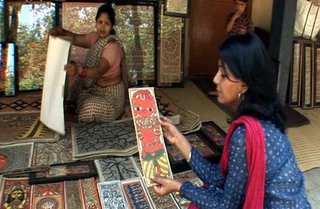[For so long I was under the impression that story tips (inclusive of background material) were meant for the mainstream media people. Today, post lunch, when I found an email in my inbox, I thought that it would the usual ones that I get in the course of my day job. But the sender’s email read cnn.com. “Why would CNN send an email to me?” Then I figured that it was actually addressed to this blog and they wanted me to post about something on their website. This little blog of mine is getting noticed. Sort of a feel good feeling. The language of such mails do act as a good ego booster.
Anyway, I’m not posting this as an ego tonic. But because I stay in the Delhi, can’t exactly say how much I can relate to it and because Nandita Das is one of the actresses that I like. I even had (still have) a poster of her’s adorning one of the walls in my room back home.]
Every city had a tale to tell; just the storyteller has to be good enough. Bigger cities like Delhi, Bombay and Calcutta have had more than their share. More not because all the stories that needed to be told have been told, but there are many cities and towns eagerly waiting for their chance. It is more likely for a resident of a larger city to know about the history of his/her city than an inhabitant of an ‘insignificant’ one. CNN’s The Scene calls itself “The Insider’s Guide to the World’s Coolest Cities.” At the last count there were 33 in all, including two of India’s Bombay (Mumbai) and now Delhi. Filmmaker Yash Chopra did the honours for India’s commercial and cinema capital and Nandita Das is now taking us on a Dilli Darshan. There’s also a video, but that didn’t play very well on my PC and ended abruptly.
CNN’s The Scene calls itself “The Insider’s Guide to the World’s Coolest Cities.” At the last count there were 33 in all, including two of India’s Bombay (Mumbai) and now Delhi. Filmmaker Yash Chopra did the honours for India’s commercial and cinema capital and Nandita Das is now taking us on a Dilli Darshan. There’s also a video, but that didn’t play very well on my PC and ended abruptly.
Nandita Das’ Delhi is “a city that sees all seasons.” Well, except one. Rainy. The last four years that I’ve been in Delhi, I’m yet to see monsoon as it is described in the books. Maybe coming from rain infested Meghalaya makes the ‘heavy showers’ look like a trickle.
And there’s the inevitable question. “How does Delhi compare to Mumbai?”
The answer is:
Delhi, less commercial. I wouldn’t say that.
Helpful and interesting is the insider’s tips section. Even you can share your suggestions. Here are a few samples and I wouldn’t contest these:
“Some cities are plagued with pigeons; Delhi’s influx of sandwich-snatching rhesus monkeys rampage around the government areas of the city (and occasionally destroy top-secret documents in the process). Look out for the langurs (larger black apes) brought in to scare off their simian cousins.”
“If you do go in winter, make the most of ‘Dilli ki Sardi‘ – the famous cold of Delhi. Muffle up in warm clothes, imbibe some hot tea and enjoy the spicy Indian food, which tastes wonderful in the cold. If you go in summer and the heat gets too much, do as the locals do and escape underground to the air-conditioned metro.”
“If the weather gets sticky, quench your thirst with jal jeera, a cumin-spiced Indian lemonade or, if you fancy a bit more of a kick, try a rum and Thums Up (Indian cola).”
Photo courtesy: CNN


wowwwwwwww..congrats bro… it’s too good. u r the best in everything u do.. hat’s off.
Wow……..wow.
I’ll come back and say some thing sensible.Right now I am just in awe.
Congratulations, that’s some achievement. I guess that would mean chai all round? *treats on you*
Bhery good!
Keep it up!
Hope you get more breaks like these. You really deserve it…
Congrats! 🙂
Dwaipayan, EducatedUnemployed, San, The Nameless One, Sunrise The comment field has definitely turned out to be an ego tonic. Honestly speaking, I wasn’t expecting any applause. I was looking forward to Delhi experiences of people who have been here (or stay here).
.hmm…is it called gratitude???or mutualism??
Dwaipayan Whatever.